 of four main components: mineral, water, air and organic.
of four main components: mineral, water, air and organic.
Soil is foundational to every garden. Every healthy, productive yard and garden starts with healthy, productive soil. Preparing the soil properly makes more difference than any other thing. Extra fertilizer and water will not make up for poor soil.
Since soils are so different in different areas, it is necessary to know what soil is, what the soil is like and what to add to improve it.
Soil is made up
 of four main components: mineral, water, air and organic.
of four main components: mineral, water, air and organic.
The mineral component is non-living material. It is divided by the size of the particles, into:
Sand: Rounded particles 1/12 to 1/500 inch (2.0 to 0.06 millimeters) in diameter.
Silt: Rounded particles 1/500 to 1/12,500 inch (0.06 to 0.002 millimeters) in diameter.
Clay: Often flattened particles less than 1/12,500 inch (0.002 millimeters) in diameter.
Loam: Mixture of the above in roughly 40% sand, 40% silt and 20% clay.
Sand has large spaces between the particles, which allow air and water to move easily, so sand has good aeration and drainage. Clay packs down with only tiny spaces between particles so there is poor aeration and drainage. However, clay has about 1,000 times the surface area as the same volume of sand. More surface area means that clay
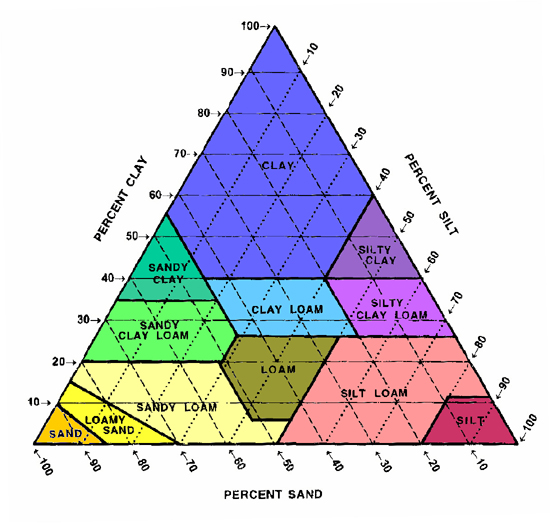 will hold more water and more nutrients. Silt has some of the qualities of both sand and clay. Loam combines the best features of all three: aeration, drainage and storage capacity for water and nutrients. Often, soil particles are clumped together into crumbs, which create large spaces between the crumbs for aeration and drainage. Pebbles and rocks also increase drainage; sometimes so much that plants wilt from lack of water. Rocks also may interfere with root growth.
will hold more water and more nutrients. Silt has some of the qualities of both sand and clay. Loam combines the best features of all three: aeration, drainage and storage capacity for water and nutrients. Often, soil particles are clumped together into crumbs, which create large spaces between the crumbs for aeration and drainage. Pebbles and rocks also increase drainage; sometimes so much that plants wilt from lack of water. Rocks also may interfere with root growth.
The amount of water in the soil is described in these ways:
Saturated: All of the spaces in the soil are filled with water.
Field capacity: Excess water has drained away leaving a film of water on each particle and air in the spaces.
Wilting Point: The film of water on each particle is so thin that plant roots can no longer pull enough water from the soil, so the leaves droop or roll.
Plants grow best
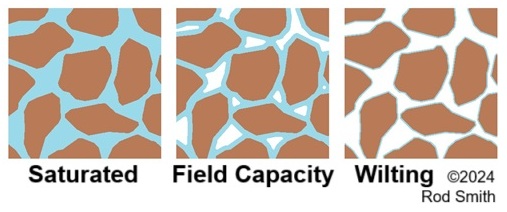 when the soil is at field capacity. Vegetable yields have been doubled by applying controlled amounts of water several times a day to well-drained soil to maintain field capacity. A simple way to maintain field capacity is to punch a small hole in the bottom of a coffee can and bury it near a tree or plant.
Filling the can every day should maintain the soil near field capacity within two or three feet of the can. However, this approach does not work well on heavy clay soil since it has poor aeration and drainage. Plants grow better on clay soils if watered to near saturation, then allowed to dry before watering again because this helps soil breathe in fresh air.
when the soil is at field capacity. Vegetable yields have been doubled by applying controlled amounts of water several times a day to well-drained soil to maintain field capacity. A simple way to maintain field capacity is to punch a small hole in the bottom of a coffee can and bury it near a tree or plant.
Filling the can every day should maintain the soil near field capacity within two or three feet of the can. However, this approach does not work well on heavy clay soil since it has poor aeration and drainage. Plants grow better on clay soils if watered to near saturation, then allowed to dry before watering again because this helps soil breathe in fresh air.
Air in the soil
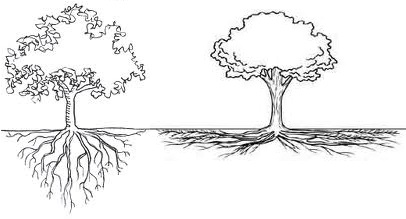 is made of the same gases as the air in the atmosphere. Air does not move as freely in the soil so there might be too much or too little of certain gases in parts of the soil. Plant roots use up oxygen to absorb water and nutrients and release carbon dioxide. The lack of oxygen produces anaerobic conditions which limits how deep roots can grow.
Roots might grow thirty feet deep in well-drained sandy soil, but most roots are in the top foot of clay soil. Oxygen is replenished in the soil when water forces the air out of the soil, then fresh air is pulled back into the soil as the water drains away. Large spaces between soil particles and crumbs allow soil to breathe better. Deep watering and drying out helps soil breathe much better so soil remains aerobic. Daily shallow watering does not help soil breathe. Keeping the soil saturated all the time greatly reduces the movement of oxygen so soil becomes anaerobic.
is made of the same gases as the air in the atmosphere. Air does not move as freely in the soil so there might be too much or too little of certain gases in parts of the soil. Plant roots use up oxygen to absorb water and nutrients and release carbon dioxide. The lack of oxygen produces anaerobic conditions which limits how deep roots can grow.
Roots might grow thirty feet deep in well-drained sandy soil, but most roots are in the top foot of clay soil. Oxygen is replenished in the soil when water forces the air out of the soil, then fresh air is pulled back into the soil as the water drains away. Large spaces between soil particles and crumbs allow soil to breathe better. Deep watering and drying out helps soil breathe much better so soil remains aerobic. Daily shallow watering does not help soil breathe. Keeping the soil saturated all the time greatly reduces the movement of oxygen so soil becomes anaerobic.
The organic component of the soil is made up of living and dead plants and animals.
Living: Bacteria, Fungi, Protozoa, Nematodes, Insects, Earthworms, and Roots.
Dead: All of the above as they decay.
Humus: Dead organic matter that has decomposed until it is very fine, black and sticky.
Bacteria and fungi extract nutrients from the soil minerals and make them available to plants. Several kinds of nitrogen fixing bacteria can pull nitrogen gas, N2, out of the air and convert it into ammonia, NH3, which plants can use. Rhizobium bacteria are nitrogen fixing bacteria that live in nodules on legume roots such as peas, beans and clover. There are also nitrifying bacteria that convert ammonia into nitrites, NO2, and nitrates, NO3. These beneficial bacteria are aerobic. There are also denitrifying bacteria that convert nitrites and nitrates back into nitrogen gas. These harmful bacteria, as well as bacteria that cause root diseases, are anaerobic.
Once I saw a field where the corn was all a healthy green color except that the corn was all yellow from a lack of nitrogen around a large puddle. The soil was all saturated under and around the puddle so the soil was anaerobic. The beneficial bacteria that fixed nitrogen were dying out while the harmful bacteria which turn nitrogen back into a gas were thriving. This is another reason why aeration and drainage are important for healthy soil.
Mycorrhizae are
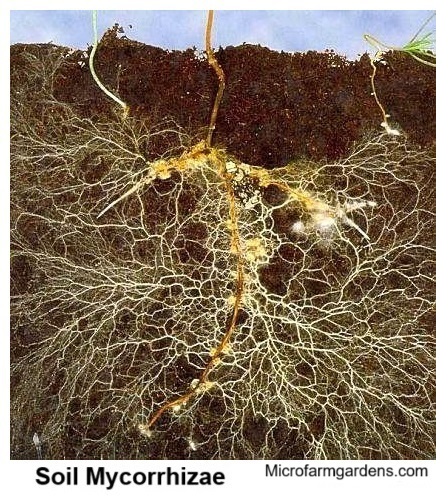 beneficial fungi that can transport a very large amount of water and nutrients to plant roots, as much as 80% of what the plant roots absorb. Different kinds of mycorrhizae benefit just about every kind of plant except the cabbage family. Ectomycorrhizae form a sheath around plants roots while endomycorrhizae grow right into plant roots.
Mycorrhizae also produce glomalin which is a sticky protein that sticks soil particles into larger clumps for better aeration and drainage. It accounts for 27% of the carbon in soil and helps reduce excess carbon dioxide in the atmosphere.
beneficial fungi that can transport a very large amount of water and nutrients to plant roots, as much as 80% of what the plant roots absorb. Different kinds of mycorrhizae benefit just about every kind of plant except the cabbage family. Ectomycorrhizae form a sheath around plants roots while endomycorrhizae grow right into plant roots.
Mycorrhizae also produce glomalin which is a sticky protein that sticks soil particles into larger clumps for better aeration and drainage. It accounts for 27% of the carbon in soil and helps reduce excess carbon dioxide in the atmosphere.
Nematodes are microscopic worms that eat bacteria and release the nutrients they contain into soil. Some kinds of nematodes also cause root diseases. Protozoa are all single celled animals that also eat bacteria as well as smaller protozoa. Flagellates are the smallest and move by waving their flagella. Amoebas are larger and move by changing shape to form a pseudopod. Ciliates are the largest and move by waving short hairs called cilia. Large numbers of ciliates indicate lower levels of oxygen in soil.
Insects and
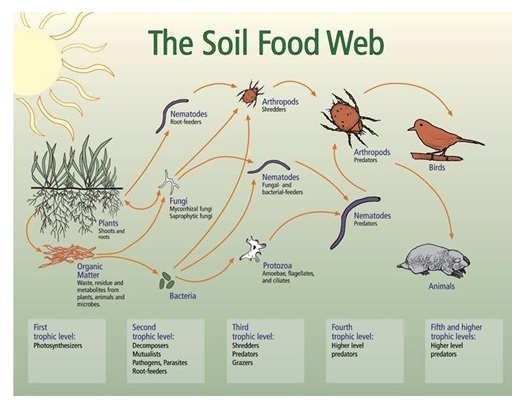 worms create air passages deep into the soil. The carbon dioxide produced by insects and roots becomes carbonic acid, which breaks down minerals to make nutrients available. Dead organic material provides rich nutrients for the living. It also holds the nutrients from applied fertilizers until the plants can use them. Humus and glomalin stick soil particles together into larger crumbs so there are bigger spaces for air and water.
worms create air passages deep into the soil. The carbon dioxide produced by insects and roots becomes carbonic acid, which breaks down minerals to make nutrients available. Dead organic material provides rich nutrients for the living. It also holds the nutrients from applied fertilizers until the plants can use them. Humus and glomalin stick soil particles together into larger crumbs so there are bigger spaces for air and water.
Dead organic matter is decaying continually, so it needs to be replenished regularly. Excessive nitrogen fertilizer will cause the dead organic matter to decay even faster; so more organic matter will have to be applied. Also, applying synthetic fertilizers and pesticides can harm or kill the living organisms and disrupt the soil ecosystem.
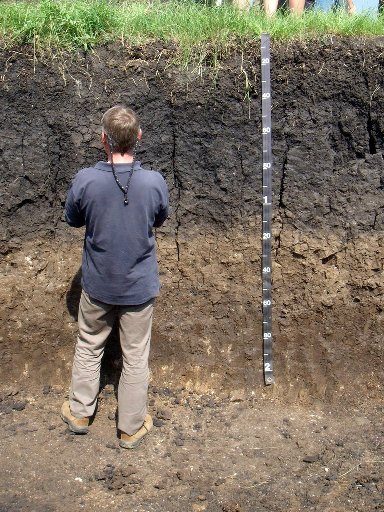 Soil testing is done to determine how much of each soil component is present in the soil. Some soils near rivers are sandy loam, but most of Washington County, OR, is mostly clay because at one time the valley floor was a lake bed. Soil testing laboratories can give a detailed and accurate measurement of the soil's components. A local soil testing lab, A & L Western Laboratories, is in Sherwood, OR. However, these simple tests can reveal much about the
soil.
Soil testing is done to determine how much of each soil component is present in the soil. Some soils near rivers are sandy loam, but most of Washington County, OR, is mostly clay because at one time the valley floor was a lake bed. Soil testing laboratories can give a detailed and accurate measurement of the soil's components. A local soil testing lab, A & L Western Laboratories, is in Sherwood, OR. However, these simple tests can reveal much about the
soil.
Fill a glass jar about half full with soil. Fill to the top with water. Shake the jar, but do not swirl. Let stand. Coarse sand will settle in about ten seconds. Fine Sand will settle in one minute. Silt will settle in two hours. Clay will take several hours to settle. Larger pieces of organic matter will float for awhile. The thickness of the layers indicates the proportions of sand, silt, clay and organic matter.
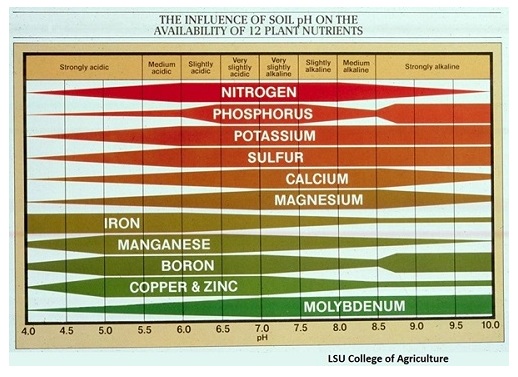 Soil pH is a measure of hydrogen ion concentration. It is tested either with a chemical pH test, or by a pH meter. 7.0 is neutral. 4.0 is very acid. 10.0 is very alkaline. High rainfall and high organic matter produces acid soil. Low rainfall and high lime or sodium produces alkaline soils. Soils in Eastern Oregon are often alkaline while soils in the Willamette Valley naturally have a pH between 4.5 and 5.5, which is fine for acid loving plants such as rhododendrons, azaleas, camellias and conifers.
Soil pH is a measure of hydrogen ion concentration. It is tested either with a chemical pH test, or by a pH meter. 7.0 is neutral. 4.0 is very acid. 10.0 is very alkaline. High rainfall and high organic matter produces acid soil. Low rainfall and high lime or sodium produces alkaline soils. Soils in Eastern Oregon are often alkaline while soils in the Willamette Valley naturally have a pH between 4.5 and 5.5, which is fine for acid loving plants such as rhododendrons, azaleas, camellias and conifers.
Lawns, roses, lilacs, fruit trees, vegetables and many flowers prefer a soil pH near neutral, 6.5 to 7.0. The majority of plant nutrients are most available at slightly acid to neutral. The availability of phosphorus drops off rapidly as pH drops below 6.5, but iron is more available as soil is more acid. Soil can be made less acid by adding lime (calcium carbonate), or more acid by adding sulfur or aluminum sulfate. Aluminum sulfate is especially helpful to produce good blue flowers on hydrangeas. Adding lime produces pink hydrangea flowers. Lime will raise the soil pH in a few weeks to several months depending on how finely ground the lime particles are. Sulfur takes about a year to lower soil pH since bacteria are required to complete the process. However, anaerobic soil will go back to being acid a few months after lime is applied because micro-organisms that thrive in anaerobic soil produce organic acids which lower pH and make soil smell sour.
The six that the plants need the most of are called Macronutrients. They are Nitrogen (N), Phosphorus (P), Potassium (K), Calcium (C), Magnesium (Mg) and Sulfur (S). The other nutrients, which are needed only in trace amounts, are called Micronutrients. They include Arsenic (As), Boron (B), Chlorine (Cl), Cobalt (Co), Copper (Cu), Iron (Fe), Manganese (Mn), Molybdenum (Mo), Nickel (Ni), Selenium (Se), Silicon (Si), Sodium (Na), Vanadium (V) and Zinc (Zn).
Nitrogen encourages leaf growth. Phosphorus encourages roots and flowers. Potassium encourages general vigor. If one of the nutrients is not available, then plant growth will be slower or stunted, and leaves will be discolored. For example, lack of nitrogen causes the old leaves to turn yellow. Lack of iron causes the new leaves to be yellow. This is because plants can move nitrogen from old leaves to new leaves, but they cannot move iron. Nutrient deficiencies cause patterns in leaves that follow the veins. It might be green veins and yellow in between or yellow veins and green in between. Some deficiencies cause purple or brown areas. Disease symptoms do not follow the veins.
Soil laboratories
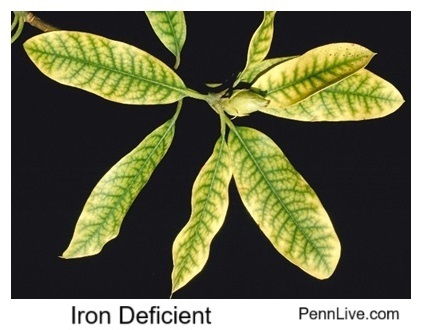 will test soils for nutrients as well as pH and organic matter. A local soil testing lab, A&L Western Laboratories , is in Sherwood, OR. They also do tissue testing to see what the nutrient levels are inside the plant. This is a more accurate indication of what nutrients need to be applied. A general recommendation is: All soils are short on nitrogen; shallow rooted plants such as lawns and flowers need extra phosphorus and potassium; iron and sulfur are often deficient, especially around acid loving plants. Usually, the soil contains enough of the other nutrients, although some may be deficient in certain parts of the country. Boron is sometimes deficient in the Pacific Northwest. Trace minerals are more likely to be available when soil is more acid.
will test soils for nutrients as well as pH and organic matter. A local soil testing lab, A&L Western Laboratories , is in Sherwood, OR. They also do tissue testing to see what the nutrient levels are inside the plant. This is a more accurate indication of what nutrients need to be applied. A general recommendation is: All soils are short on nitrogen; shallow rooted plants such as lawns and flowers need extra phosphorus and potassium; iron and sulfur are often deficient, especially around acid loving plants. Usually, the soil contains enough of the other nutrients, although some may be deficient in certain parts of the country. Boron is sometimes deficient in the Pacific Northwest. Trace minerals are more likely to be available when soil is more acid.
Fertilizers are available to provide extra nutrients. The exact numbers are not as important as the proportions. A 5-5-5 fertilizer works the same as a 15-15-15, except that it takes three times as much 5-5-5 to provide the same nutrients. The optimum fertilizer for lawns has an N-P-K ratio of 3-1-2, such as a 15-5-10. Fertilizers with similar ratios are interchangeable, except that some fertilizers, such as rose food, contain extra calcium carbonate to raise pH and some fertilizers, such as rhododendron-azalea food, contain extra sulfur to lower pH.
The nutrients are identical whether they come from organic or synthetic sources, but the source will affect how fast the nutrients are available to plants. Ammonium sulfate and water soluble fertilizers release most of their nitrogen in a few days and might burn plants if too much is applied at one time. Blood meal releases its nitrogen over a period of months. Organic fertilizers and specially treated synthetic fertilizers are slow release so they will not burn and the nitrogen will not wash away in the rain before plants can use it. Also, phosphorus is quickly tied up into insoluble compounds in acid soils, so bone meal or a slow release fertilizer is a much better source of phosphorus.
When fertilizing trees or shrubs, spread the fertilizer evenly from the trunk to beyond the length of the branches. There are feeder roots throughout the area, not just at the drip line. Water soluble fertilizers can be applied to the leaves since they will absorb directly. This will green up the leaves, but it does not encourage growth.
Permaculture is a completely different
approach that started catching on about 20 years ago. According to Dr. Elaine Ingham, there is enough phosphorus in a single
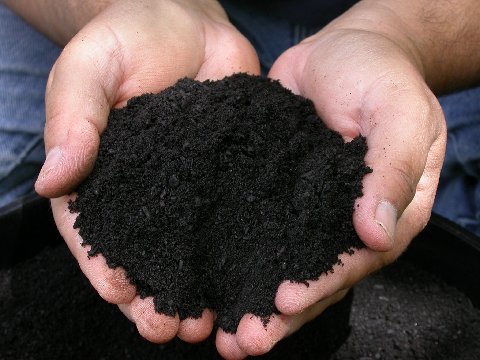 grain of sand to feed an acre of plants for a year. There are already plenty of nutrients in the soil if the right mix of micro-organisms are in the soil to extract the needed nutrients.
grain of sand to feed an acre of plants for a year. There are already plenty of nutrients in the soil if the right mix of micro-organisms are in the soil to extract the needed nutrients.
Permaculture begins with collecting a tablespoon of moist duff from a nearby woods which should contain beneficial micro-organisms suited to the area. This is placed in a tank where air is pumped through the water where they will multiply. The water is regularly applied to manure and other organic matter to produce high quality compost. A ton of this compost is applied per acre to introduce and support the growth of a mix of beneficial soil micro-organisms including bacteria, fungi, nematodes and protozoa. These will multiply in the right mixture according to what plants need as long as the soil remains aerobic and soil pH remains near neutral. Much more information about Dr. Ingham and Permaculture is available on the Internet.
An ideal garden soil would contain about 35% sand, 35% silt, 20% clay and 10% organic matter to improve aeration and drainage as well as to hold nutrients until plants can use them. It would also be uniformly mixed to at least twelve inches deep. The subsoil would allow excess water to drain away. No soil is ideal but soil can be improved with soil amendments and drainage.
Amendments that are commonly added to soil are:
Compost is made of partially decomposed yard debris, bark dust, sawdust, manure or other organic matter. Fresh organic matter can also be used, but extra nitrogen fertilizer will be needed to help it decompose. Fresh manure may contain too much uric acid, which can burn roots. It is best if manure is aged for at least six months.
Adding
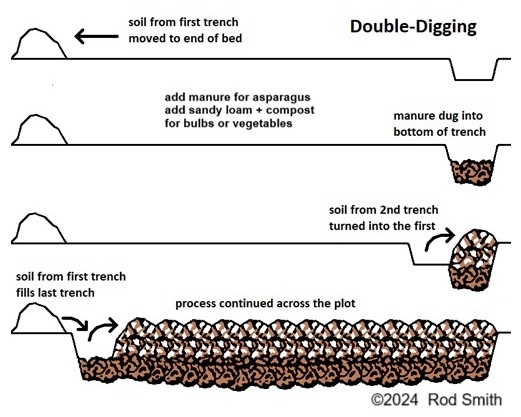 compost to sandy loam soil makes it hold more water and nutrients. Compost is also helpful for clay soil, but clay needs amendments to improve aeration and drainage. Concrete sand creates spaces much better than river sand, which has rounded edges and packs down tighter. Quarter-ten crushed rock is better than sand. Pumice is even better, because it has air pockets which can hold moisture and nutrients. Profile Soil Conditioner is like a manufactured pumice. Potting soil which contains sand or pumice is a good soil amendment if a small amount is needed. Large amounts can be purchased by the truckload from landscape supply yards. Amendments should be dug or tilled into the top foot of soil to improve both aeration and drainage.
compost to sandy loam soil makes it hold more water and nutrients. Compost is also helpful for clay soil, but clay needs amendments to improve aeration and drainage. Concrete sand creates spaces much better than river sand, which has rounded edges and packs down tighter. Quarter-ten crushed rock is better than sand. Pumice is even better, because it has air pockets which can hold moisture and nutrients. Profile Soil Conditioner is like a manufactured pumice. Potting soil which contains sand or pumice is a good soil amendment if a small amount is needed. Large amounts can be purchased by the truckload from landscape supply yards. Amendments should be dug or tilled into the top foot of soil to improve both aeration and drainage.
For flower bulbs and root crops, the soil should be double dug to fifteen to eighteen inches deep. Double digging involves digging up the top shovel depth of soil and piling it to the side of the hole. Soil amendments are spread in the hole and worked into the lower shovel depth. Then amendments are added to the piles of soil as they are shoveled back into the hole. Bulbs can be planted as the hole is filled.
Soil should be
 worked when it is moist but not wet. Wet soil will be packed into hard clods, which are about like rocks. To check the soil for dampness, squeeze a handful of soil into a ball, then push your thumb into the ball. It should crumble, not dent like modeling clay. Dry soil is harder to work and the soil disintegrates into dust. Dust will turn into mud when watered, then dry like brick. Dry soil should be watered with an inch of water then allowed to soak in for a day or two before tilling.
worked when it is moist but not wet. Wet soil will be packed into hard clods, which are about like rocks. To check the soil for dampness, squeeze a handful of soil into a ball, then push your thumb into the ball. It should crumble, not dent like modeling clay. Dry soil is harder to work and the soil disintegrates into dust. Dust will turn into mud when watered, then dry like brick. Dry soil should be watered with an inch of water then allowed to soak in for a day or two before tilling.
Soil should not be worked into dust. Leaving marble-sized to golf ball-sized clumps will give better aeration and drainage. Besides destroying the structure of soil, over working soil also kills off the mycorrhizae which are beneficial fungi which help move nutrients from soil into roots. Roto-tilling may be required to incorporate amendments into the soil but more mycorrhizae will survive if the soil is loosened with a spading fork. Simply stomp the tines into the soil and tilt back the handle to lift and fracture the soil.
The best and easiest time to improve soil is to do an entire area at once, such as when planting a new lawn or landscape. The amendments should be spread evenly over the area and worked into the soil at least ten inches deep. A shovel or spading fork works best for small areas. A roto-tiller handles large areas. For existing beds, the soil can be improved every time something is planted. A planting hole should be at least three times as wide as the root ball and about the same depth. Mix evenly 1 part soil amendments to 3 to 4 parts of the soil from the hole. I always shovel the soil into large plastic pots or a wheelbarrow to make it easier to mix the soil, and the soil is not lost into the grass or mulch.
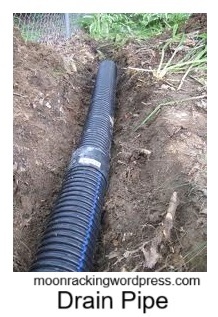 least a foot tall or on a slope. Vegetables are best grown in raised beds, which provide better drainage so soil will warm up faster in the spring for an earlier start.
least a foot tall or on a slope. Vegetables are best grown in raised beds, which provide better drainage so soil will warm up faster in the spring for an earlier start.
In mostly flat yards, subsurface drainage might have to be provided. Perforated plastic drainpipe can be buried about a foot deep. It is important that drainpipes slope evenly so dirt does not clog up the low spots. Drain pipes can drain onto the street or into down spouts if allowed by local building codes.
Aeration can be improved on existing lawns and beds without tearing up the soil. Sod core aerators cut out plugs of soil and leave holes about six inches apart and four inches deep. Root feeders can be used around trees and shrubs to create holes eighteen inches deep. These holes allow air and water to quickly penetrate deep into the soil. The holes will stay open much longer if sand or Profile Soil Conditioner is raked into the holes to fill them.
Home Page
Site Map
Preferred Soil pH
Plant Nutrients
Planting in Clay Soil